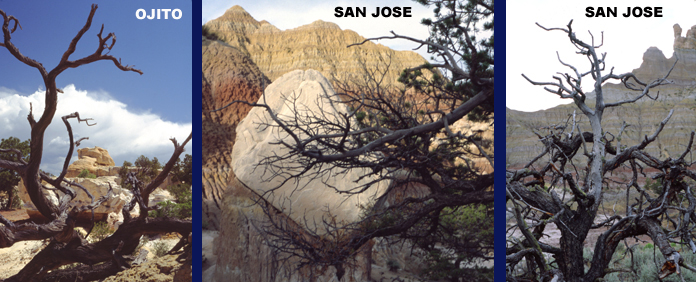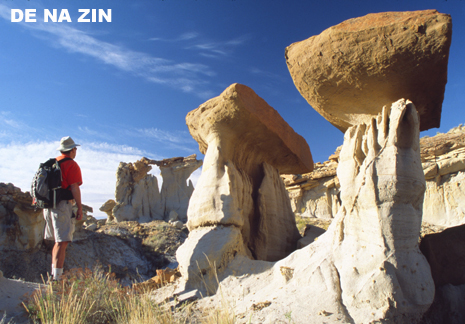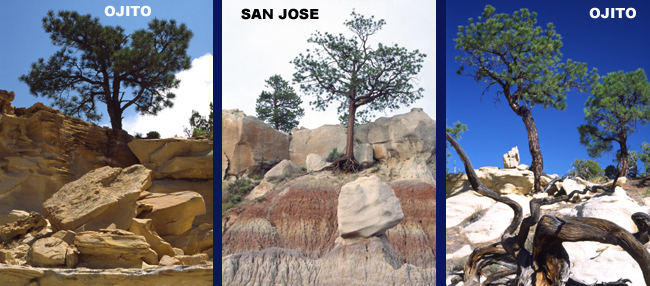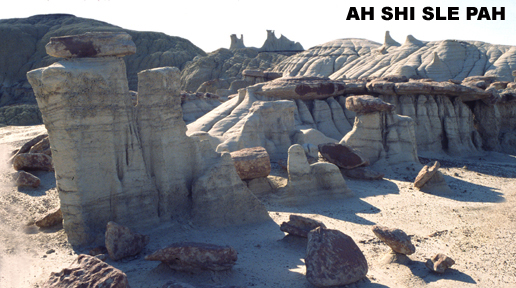
PHOTOGRAPHING THE SAN JUAN BASIN BADLANDS
The San Juan Basin badlands offer exceptional photographic opportunities and challenges. High desert light is crystal clear yet constantly changing. Brightness, angle, and mood vary with time of day and the seasons. The fabled early morning or late afternoon which photographers call the “magic hours” or “sweet light” is never sweeter than in the wide open vistas of the high desert. Diverse rock formations including banded mesas, intricately sculpted spires, and otherworldly hoodoos are a cornucopia of form, texture, and color. Soaring vistas and towering cloudscapes form dramatic backdrops. These landscape elements combined with the amazing light create a gigantic outdoor laboratory in which to experiment and perfect some very important photographic techniques. On the other hand, the same fantastic lighting and diverse scenic elements may sometimes be “too much of a good thing” when not managed properly. Intense rays and reflecting surfaces cause exposure problems and produce flat, washed out scenes or too much contrast. The exceptional detail and variety of forms can be overwhelming and distracting when composing.
In the high desert badlands, whether your medium is sensor or celluloid, the initial challenges of maximizing correct exposure and depth of field while controlling contrast remain the same. I have a huge collection of transparencies gathered over the years which I now scan to take advantage of the power of Adobe Photoshop. I’m also transitioning into digital as the technology grows ever more powerful and cost effective. My basic badlands photographic tools and techniques are: 1) a polarizer; 2) a wide angle zoom; 3) exposure bracketing; 4) carefully selecting the appropriate sun and camera angles; 5) a friend with a hat to provide a lens shade; and 6) friends to act as models.
Here are some common challenges and how I deal with them. Challenge # 1: ELIMINATING UNDEREXPOSURE Intense sun, flat surfaces, and light rock colors combine to act much like snow by reflecting light and misleading your light meter into setting an exposure 1-2 stops below the correct one. The solution is to overexpose and then bracket. A polarizer reduces the glare and balances the overexposure by saturating colors. I usually use a wide angle lens which further increases the tendency for underexposure. So for bright scenes I typically bracket in 1/3 stops from +7 to +1.3 over the meter reading. Challenge #2: MANAGING CONTRAST The ability of any film or sensor to simultaneously capture highlight and shadow details (dynamic range) can be put to the test by the extreme lighting conditions in the badlands. Washed out highlights and/or coal black shadows are the results. A polarizer helps reduce glare and restore highlight details. Bracketing produces a series of images with varying amounts of shadow versus highlight details to select from when working in Adobe Photoshop. I adjust my shooting position relative to the sun angle in order to maximize the amount of shadow or highlight areas depending on what effect I want for any given image. Challenge #3: MAXIMIZING DEPTH OF FIELD Myriad forms and intricate textures are the primary thematic elements in most badlands images, so maximizing depth of field is usually very desirable. Start by using the smallest aperture possible when shooting handheld, or get really serious and use a tripod to stop down all the way. Wide angle lenses have inherently greater depth of field at any aperture. I typically use as wide a focal length as possible and move closer or farther from the center of interest to compose rather than adjust the zoom.
Challenge #4: MAXIMIZING 3-DIMENSIONALITY The surest way to convey the amazing detail of the badlands formations and the expansive distances of the surrounding vistas is to shoot during the morning or late afternoon instead of at high noon. Oblique sun angles create shadows which enhance the 3-demensionality of the scene. Taking this technique to the extreme means being out there just after dawn or before sunset to catch the light during the “magic hours” when depth is enhanced by the warm, dream like illumination. Strange badlands formations are surreal enough in any light but during these times they appear otherworldly. Depending on what effect I’m looking for, I adjust my shooting position relative to sun angle to either maximize or minimize shadows. Seasons also affect the mood of the high desert light. During late fall, winter, and early spring the sun is lower in the sky producing softer, more oblique rays which help reduce several of the problems discussed previously. Challenge #5: USING BACKLIGHTING AND ELIMINATING LENS FLAIR Experimenting with different camera and sun angles to obtain unique perspectives and effects is a large part of the fun in badlands photography. I regularly shoot toward the sun for backlighting or even include the sun in the image just to see what effect I can achieve. Both these situations cause the meter to underexpose the image. So overexpose up to 1 stop and bracket for normal backlighting and up to 2 stops with the sun in the frame. Since I often use a wide angle lens, sun flair is a constant problem. Lens shades, cupped hands, adjustments to camera angle, or taking advantage of existing shade can only go so far in eliminating lens flair. The surest way to control it for extreme sun angles is to have a friend shade the lens with a hat.
Challenge #6: VITALITY OF COMPOSITION The whole point of badlands photography is to go with the strange, abstract surroundings and stretch your imagination. Experiment with different focal lengths, sun and camera angles, and exposures. One of my favorite techniques is to use a 24mm or 17mm lens to get close and capture the intricate detail in a particularly interesting foreground hoodoo while also getting sharp images of the surrounding forests of weird shapes as background. A wide angle lens can be tilted to produce mild image distortion which adds to the surreal quality of the badlands. At other times I zoom in and showcase exceptionally artistic individual formations like fine sculpture. People appear incongruent and hence dramatic against the weird formations. I often include them in the image for size perspective and “human interest” – something I learned as a freelance outdoor travel writer and photographer. Pure white cumulus clouds billowing high into the stratosphere and stunted, character laden old desert junipers or even their downed skeletons increase the compositional possibilities. Link to Tree Photos. Link to Cloudscapes. Without a doubt though, the most important photographic technique is to have as much fun as possible.
|
| HOME |
GEOLOGY |
PHOTOGRAPHY TIPS | RECREATION | MAP - INDIVIDUAL BADLANDS |
| INDIVIDUAL BADLANDS PAGE | PHOTO TOURS |
BADLANDS OVERVIEW |
This site is property of PhotoTrekNM. All rights reserved. Copyright 2007.





